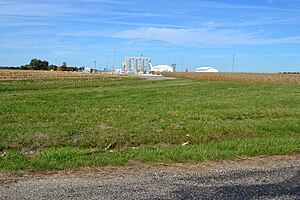Earth:Glasford crater
 Site of crater from south, at intersection of Cowser and Kingston Mines Rds. | |
| Impact crater/structure | |
|---|---|
| Confidence | Confirmed |
| Diameter | 4 kilometres (2.5 mi) |
| Depth | 350 metres (1,150 ft) |
| Age | < 430 Ma |
| Exposed | No |
| Drilled | Yes |
| Location | |
| Coordinates | [ ⚑ ] : 40°36′N 89°47′W / 40.6°N 89.783°W |
| Country | USA |
| State | Illinois |
| Municipality | Glasford, Illinois |
| Lua error in Module:Location_map at line 522: Unable to find the specified location map definition: "Module:Location map/data/Illinois" does not exist. | |
The Glasford crater, also known as the Glasford Disturbance, Glasford Structure,[1] and Glasford Cryptoexplosion Structure[2], is a buried impact crater in southern Peoria County, Illinois, in the United States.[3] It is one of two known meteor craters in Illinois.[4]
It is 4 kilometers (2.5 mi) in diameter and the age is estimated to be less than 430 million years (Silurian or younger).[5][6] It was formed in a marine environment in the Late Ordovician period.[7][8] The meteorite is estimated between 50 and 90 million tons and likely originated in the asteroid belt between Mars and Jupiter.[9]
The Glasford crater was discovered by the Central Illinois Light Company (formerly CILCO, now Ameren) while drilling wells for underground natural gas storage.[10][11] It is not visible from the surface, as it is covered by agricultural farmland.[12][11] The present day location is near the intersection of Cowser and Kingston Mines roads.[9] It was identified in 1963 as a probable impact structure.[5][13] In the 1980s, scientists identified shatter cones.[5] Geologists estimate the meteor released a large amount of energy, roughly equivalent to 20,000 nuclear bombs, 460 million tons of TNT, or two to three times the energy of the Mount St. Helens eruption.[11][9]
According to research by geologist Charles Monson, the Glasford crater may be connected to the Great Ordovician Meteor Shower.[14] Dr. Birger Schmitz's study suggests that the dust from the meteor impact may have impacted Earth's climate and contributed to the mid-Ordovician Ice Age.[4][14]
References
- ↑ Freeberg, Jacquelyn H. (1966) (in en). Terrestrial impact structures: a bibliography. Washington: U.S. Govt. Print. Off. pp. 42. https://catalog.loc.gov/vwebv/search?searchCode=TALL&searchArg=Terrestrial+Impact+Structures+A+Bibliography&searchType=1&limitTo=none&fromYear=&toYear=&limitTo=LOCA=all&limitTo=PLAC=all&limitTo=TYPE=all&limitTo=LANG=all&recCount=25.
- ↑ Ryan, Robert; Buschbach, T. C. (1963). "Tectonic History of the Glasford Cryptoexplosion Structure: ABSTRACT" (in en-US). AAPG Bulletin 47 (2): 368–369. ISSN 0149-1423. http://archives.datapages.com/data/bulletns/1961-64/data/pg/0047/0002/0350/0368c.htm.
- ↑ "Glasford". Earth Impact Database. Planetary and Space Science Centre University of New Brunswick Fredericton. http://www.passc.net/EarthImpactDatabase/New%20website_05-2018/Glasford.html. Retrieved 2009-08-13.
- ↑ 4.0 4.1 Jolley, Tiffany (2019-11-12). "Prairie Research Institute News" (in en-US). https://blogs.illinois.edu/view/7447/804191.
- ↑ 5.0 5.1 5.2 Monson, Charles C.; Sweet, Dustin; Segvic, Branimir; Zanoni, Giovanni; Balling, Kyle; Wittmer, Jacalyn M.; Ganis, G. Robert; Cheng, Guo (2019). "The Late Ordovician (Sandbian) Glasford structure: A marine‐target impact crater with a possible connection to the Ordovician meteorite event" (in en). Meteoritics & Planetary Science 54 (12): 2927–2950. doi:10.1111/maps.13401. ISSN 1086-9379. https://www.osti.gov/biblio/1767765.
- ↑ "Glasford". http://www.passc.net/EarthImpactDatabase/New%20website_05-2018/Glasford.html.
- ↑ Alwmark, C; Monson, C.C. (2021). "The Late Ordovician (Sandbian) Glasford structure: A marine‐target impact crater with a possible connection to the Ordovician meteorite event". 52nd Lunar and Planetary Science Conference 2021 54 (12): 2927–2950. doi:10.1111/maps.13401. https://onlinelibrary.wiley.com/doi/full/10.1111/maps.13401.
- ↑ Buschbach, Robert Ryan T. C. (1963). "Ordovician Explosion Structure at Glasford, Illinois". AAPG Bulletin 47. https://www.researchgate.net/publication/308492538.
- ↑ 9.0 9.1 9.2 "Meteor cratered central Illinois". Burlington Hawk Eye: pp. 4. 1999-09-20. https://www.newspaperarchive.com/us/iowa/burlington/burlington-hawk-eye/1999/09-20/page-4/.
- ↑ Meteorite Research - Progress Report , Research Subcommittee, Associate Committee on Meteorites, National Research Council of Canada, 1967
- ↑ 11.0 11.1 11.2 Vlahos, Nick (2017-02-20). "Nick in the AM: When a meteor landed near Glasford" (in en-US). https://www.pjstar.com/story/news/columns/nick-in-the-morning/2017/02/20/nick-in-am-when-meteor/22422971007/.
- ↑ "GLASFORD IMPACT STRUCTURE – Crater Explorer" (in en-US). https://craterexplorer.ca/glasford-impact-structure/.
- ↑ "Where Meteor Crashed Near Glasford". Peoria Journal Star. 1963-04-09.
- ↑ 14.0 14.1 Shelley, Tim (2019-11-19). "Glasford Meteor May Have Played A Role in Ancient Ice Age" (in en). https://www.wcbu.org/peoria-public-radio-news/2019-11-19/glasford-meteor-may-have-played-a-role-in-ancient-ice-age.
 |



